|
|
|
Sort Order |
|
|
|
Items / Page
|
|
|
|
|
|
|
| Srl | Item |
| 1 |
ID:
120304
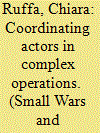

|
|
|
|
|
| Publication |
2013.
|
| Summary/Abstract |
International responses to conflicts and humanitarian emergencies have become more crowded. Not only do traditional actors intervene on a greater scale, such as non-governmental organizations and the military, but new actors such as Private Military Security Companies also play an increasingly important role. These actors often differ in their precise objective and the constituencies they are accountable to. Yet, the practices of these actors in operations are intertwined and many of their tasks overlap. Improved communication and coordination of these actors in complex operations can thus be expected to lead to strong increases in mission effectiveness. This Special Issue provides a conceptual platform to understand and explain under what conditions coordination among these actors occurs. The articles cluster around three themes. A first set focuses on who the actors involved are along a private vs public and military vs civilian divide; a second group of articles assesses experiences of coordination of different actors in the field; finally, a third looks at a plurality of elements that may trigger or hinder coordination.
|
|
|
|
|
|
|
|
|
|
|
|
|
|
|
|
| 2 |
ID:
134008
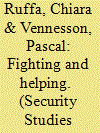

|
|
|
|
|
| Publication |
2014.
|
| Summary/Abstract |
In complex humanitarian emergencies, why are NGO-military relations cooperative in some cases, yet deeply conflictual in others? Drawing on historical-institutionalist theoretical insights, we argue that NGOs and military organizations are embedded in, and responding to, domestic institutional configurations that define a set of political incentives and constraints, material and normative, which structures and influences the characteristics and outcomes of their relations. Counterarguments suggest that organizational differences and the nature of their missions affect NGO-military relations. Using fresh empirical evidence we assess these arguments by comparing the Italian and the French experiences of NGO-military relations during the NATO-led International Security Assistance Force (ISAF) mission in Afghanistan and the UN mission in Lebanon (UNIFIL II) between 2007 and 2011.We find that domestic institutional configurations are not left behind when NGOs and military units deploy abroad. Rather, they shape NGOs' and militaries' capacity to work together instead of at cross purposes and ultimately influence the success of international action.
|
|
|
|
|
|
|
|
|
|
|
|
|
|
|
|
| 3 |
ID:
148253
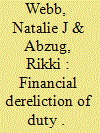

|
|
|
|
|
| Summary/Abstract |
Charity watchdogs and the media level serious allegations of mismanagement of funds at charities serving former and current members of the U.S. armed services, affecting service recipients, families, donors, grantors, foundations, and taxpayers. To examine these allegations, we use two approaches from the literature to assess nonprofit financial effectiveness: the organization’s ability to gain resources and to sustain activities. We mirror the approach of charity raters, whose measures are widely available to the public. Using GuideStar/Internal Revenue Service data, we compare fund-raising expenditures, assets, and financial sustainability of large national military and veterans nonprofits to a random sample of national nonprofits. We apply propensity score matching and compare organizations similar in size, age, and other factors. We find little difference between military and veterans charities and other nonprofits and provide an improved method for evaluating the financial health of nonprofits across academic discipline, nonprofit field of service, and within or among countries.
|
|
|
|
|
|
|
|
|
|
|
|
|
|
|
|
| 4 |
ID:
165355
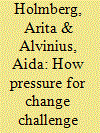

|
|
|
|
|
| Summary/Abstract |
This article elaborates on how structural, normative and functional pressures for change may challenge military organizational characteristics. We problematize theoretically and exemplify empirically what consequences these pressures can have on military organizational characteristics, arguing that they constitute major challenges for managing in particular normative pressures for change. The empirical examples suggest that bureaucratic, hierarchical, narcissistic and greedy traits of the organization are challenged by normative pressures such as value changes and normalization. Another source of challenge is professionalization processes. Structural challenges, on the other hand, are managed by the organization and do not seem to inhibit the workings of organizational characteristics. The plausibility probe conducted questions the sustainability of military organizational characteristics in their traditional disguise, in particular due to legitimacy concerns. It is suggested that future research should be directed towards analyzing how military organizations manage pressure for change and whether their characteristics are questioned.
|
|
|
|
|
|
|
|
|
|
|
|
|
|
|
|
| 5 |
ID:
069889
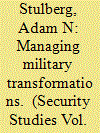

|
|
|
|
|
| Publication |
2005.
|
| Summary/Abstract |
How did the U.S. Navy successfully manage the carrier revolution? This hallmark case challenges traditional explanations of organizational change. Decisive reforms were enacted. The new vision of naval warfare thrived before the "old" battleship-centric orthodoxy was discredited, before it was fully understood, and before its champions seized power within the service. This article posits a modified principal-agent framework to explicate systematically the interplay between new interests and ideas that lie at the crux of managing the diffusion of innovations within military organizations. The main finding is that the nebulous exploration and outcome of transformation rests on strategies employed by service entrepreneurs for lowering the material cost of oversight and invoking established managerial norms that align incentives and "common knowledge" for change within military hierarchies. Evidence from the U.S. Navy's interwar experience with carrier aviation illustrates this administrative dimension to organizational change. The conclusion reviews directions for extending the argument, and lessons for managing contemporary military transformation.
|
|
|
|
|
|
|
|
|
|
|
|
|
|
|
|
| 6 |
ID:
100952
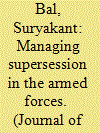

|
|
|
|
|
| Publication |
2010.
|
| Summary/Abstract |
Supersession is too important an aspect of organizational existence to be dismissed lightly. It is a situation to be managed jointly by the organization and affected individual with the clear understanding that organizational interests are overriding. The Human Resources Management (HRM) approach aims to ensure that staffing manning of an organization effectively meets the quantitative and qualitative aspects at all times to ensure efficiency and effectiveness. An important element of HRM is Human Resource Planning (HRP). This calls for long-term manpower projections based on which intake would be determined. This paper makes attempt to identify key issues using the 'HRM approach' in managing supersession. While staking no claim to provide definitive answers (a rather tall expectation) the endeavour has been to highlight an approach within the framework of contemporary motivational theories.
|
|
|
|
|
|
|
|
|
|
|
|
|
|
|
|
| 7 |
ID:
137613
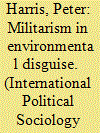

|
|
|
|
|
| Summary/Abstract |
What is the relationship between militarized landscapes, especially overseas military bases, and the natural environment? Scholars have noticed that militarized spaces—permanent bases, demilitarized zones, live fire ranges, training areas, historical battlefields and so forth—are often accompanied by de facto nature reserves. Thus, the unparalleled seclusion that militarization imposes upon delineated geographic spaces can create safe havens for plants and animals that would otherwise suffer from human encroachment. Others retort that military activities cause severe damage to the natural environment. In this article, I problematize attempts to evaluate the environmental impact of militarized spaces in a way that divorces the natural environment from the broader web of social and political relations to which military activities belong. In particular, I argue that environmental issues often serve as “greenwash” to distract attention—lay, scholarly, and official—from the negative aspects of militarism, including instances of environmental degradation, the mistreatment of human subjects, and the perpetuation of colonial forms of government. To illustrate and buttress my argument, I present a detailed case study of the US military base on Diego Garcia in the British Indian Ocean Territory.
|
|
|
|
|
|
|
|
|
|
|
|
|
|
|
|
| 8 |
ID:
138987
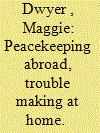

|
|
|
|
|
| Summary/Abstract |
This article draws attention to a trend in which military deployments as part of peacekeeping missions have triggered army mutinies in some West African countries. It explains how participation in peacekeeping missions created new material grievances and a sense of injustice amongst the peacekeepers, which under certain conditions sparked domestic mutinies. These uprisings in West Africa follow a history of military disobedience in the region, and the article places them in the context of long-standing tensions within military organizations. Mutinies often symbolize and intensify divisions within armed forces, which can lead to further instability even after the mutiny is resolved. Therefore, it is important for those interested in building and maintaining effective militaries to understand the ways in which deployments and peacekeeping participation can contribute to unrest within the armed forces. The article draws on interviews with former mutineers, including peacekeepers, and others military personnel in West Africa, as well as media reporting, including public statements made by mutineers, academic writing, and archival research.
|
|
|
|
|
|
|
|
|
|
|
|
|
|
|
|
| 9 |
ID:
185261
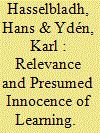

|
|
|
|
|
| Summary/Abstract |
Responding to Soeters and Talbot and Fischer, we clarify our position that learning in military organizations is highly contingent on established organizational frameworks, vocabularies, and understandings and constrained by existing power relations. The danger present in military operations increases the importance of minimizing internal frictions and constrains local experimentation and the application of different solutions. Thus, while there is learning in military organizations, the latter are less prone than large, civilian organizations to venture into the use of new and unproven solutions. The present debate about learning in military organization reflects the different basic assumptions about formal organizations in management studies as opposed to the field of organizational sociology.
|
|
|
|
|
|
|
|
|
|
|
|
|
|
|
|
| 10 |
ID:
129257
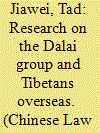

|
|
|
|
|
| Publication |
2013.
|
| Summary/Abstract |
In 1956, after the defeat of the armed insurrection launched by the reactionary upper stratum in the Sichuan Ganzi Tibetan Autonomous Prefecture, a number of armed rebels who escaped destruction crossedthe Jinsha River toward the West and fled to various areas in Tibet. Someof them, headed by Andruk-tsang Gonpo Tashi, mustered some remnant bandits from Sichuan, Qinghai, Gansu, and Yunnan provinces and setup an army called Four Rivers and Six Ranges Defenders of the Faith(hereafter, Defenders of the Faith), which was supported and supplied with arms and equipment by anti-China forces in the United States andIndia. In March 1959, the reactionary Tibetan upper stratum launched their all-out counterrevolutionary armed insurrection in Lhasa. The reactionary elements then fled to India, taking along the Dalai by force, together with about 20,000 armed rebels. These, plus about 40,000 Tibetan masses whowere strong-armed into following the Dalai, fled to such places as India, Nepal, Bhutan, and Sikkim. Most of these later assembled in India. For thesake of controlling the armed personnel and stabilizing the social order, the Indian government at the time took over their weapons, detained and screened them, and emplaced them in groups.
|
|
|
|
|
|
|
|
|
|
|
|
|
|
|
|
| 11 |
ID:
100020
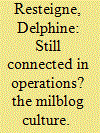

|
|
|
|
|
| Publication |
2010.
|
| Summary/Abstract |
With the development of new information and communication technologies, military organizations are confronted with a proliferation of new informal channels used by soldiers, such as military blogs (or 'milblogs'). These consist of small websites created by defence personnel around military topics. Because they have the potential to reach a large audience, milblogs have become influential and, sometimes, controversial, pushing military organizations to be more open but also to try to control them. This article first describes the new forms of communication in the military, both at the institutional and at the individual level. Next it discusses the use of milblogs among Belgian soldiers in the field and the wider role played by the internet in operations, both as an information tool and a way to break the routine of the mission. Finally it examines how these information flows, while offering more diverse perspectives, also compete with official bureaucratic channels and elements of military culture.
|
|
|
|
|
|
|
|
|
|
|
|
|
|
|
|
|
|
|
|
|